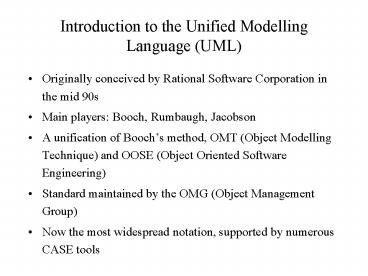Introduction to the Unified Modelling Language UML - PowerPoint PPT Presentation
1 / 9
Title:
Introduction to the Unified Modelling Language UML
Description:
... OMT (Object Modelling Technique) and OOSE (Object Oriented Software Engineering) Standard maintained by the OMG (Object Management Group) ... – PowerPoint PPT presentation
Number of Views:266
Avg rating:3.0/5.0
Title: Introduction to the Unified Modelling Language UML
1
Introduction to the Unified Modelling Language
(UML)
- Originally conceived by Rational Software
Corporation in the mid 90s - Main players Booch, Rumbaugh, Jacobson
- A unification of Boochs method, OMT (Object
Modelling Technique) and OOSE (Object Oriented
Software Engineering) - Standard maintained by the OMG (Object Management
Group) - Now the most widespread notation, supported by
numerous CASE tools
2
What is the UML?
- A language and a notation
- A set of diagramming techniques which model
- the users view (a user could be human or another
system) - structure of a problem or solution
- behaviour of a system
- implementation of a system
- deployment
- A consistent notation which can be used
throughout - requirements gathering
- analysis
- design
- implementation
- Unlike the OMT, the UML is not a methodology, but
it does provide flexible and extensible tools to
support a process
3
Why bother?
- Documentation of designs for future reference
- The need for clear communication between
- customers
- analysts
- designers
- coders
- testers
- managers
- As systems increase in size and complexity,
visualisation, specification and communication
become increasingly difficult and increasingly
important - It is a matter of scale
- for small scale systems, you probably dont
need it - for medium scale systems you could get away
with a class diagram, and maybe some use cases - for large scale systems you may need the full
range of techniques
4
UML views
- User view
- used to describe the functionality of the system
that the users expect - users can be human operators or other systems
- Structural view
- also referred to as the static or logical view
- shows the structure of a problem or solution
- Behavioural view
- presents the dynamics of the system - what
happens (or might happen) at run-time - interactions between users and the system, and
between elements of the system - Implementation view
- organisation of implementation components
- Environment view
- mapping of implementation components onto
processing resources
5
Diagram types
- User view
- use case diagram
- Structural view
- class diagram
- object diagram
- Behavioural view
- sequence diagram
- collaboration diagram
- statechart diagram
- activity diagram
- Implementation view
- component diagram
- Environment view
- deployment diagram
6
Diagram types continued...
- Use case diagrams
- describe the system from the perspective of
external actors - useful during requirements analysis and
specification - Class diagrams
- show the static structure of the system
- how it is declared rather than how it behaves
- shows classes and relationships (associations,
inheritance, aggregation, etc.) - Object diagrams
- are an instance of a class diagram
- show the objects and relationships at a specific
point in time - in a dynamic system (where objects are
created/destroyed on-the-fly) there may be many
possible object diagrams - used to validate the class diagram
7
Diagram types continued...
- Sequence diagrams
- describe the behaviour of the system to actors
- contain classes that exchange messages
- are time ordered
- Collaboration diagrams
- show how behaviour is realised by parts of the
system - classes, associations and message exchange
sequences that realise a particular behaviour - Statechart diagrams
- describe the response of a class to external
stimuli - show the life-cycle of an object
- Activity diagrams
- describe the behaviour of a class in response to
internal processing rather than external events
8
Consistency between views
- UML diagrams present different views of a
problem/solution - These views must be consistent
- Examine how they reflect related aspects of
system structure or behaviour - Some examples
- object diagrams must be consistent with the class
diagram in terms of multiplicity and
relationships between objects - sequence diagrams show the interactions between
system objects and actors in order to realise
some required behaviour, and should therefore be
consistent with the use cases - diagrams showing interactions between objects
must be consistent with the relationships
depicted on the class diagram - collaboration and sequence diagrams are
semantically equivalent - sequence diagrams emphasise the time ordering of
interactions - collaboration diagrams emphasise the organisation
of objects that interact
9
Key points
- UML is the most widespread analysis and design
notation - UML can be used to specify and model a problem or
solution at all stages of development - UML is not a methodology
- if you want to understand the analysis and design
process, then a UML text will not help you much - check out some of the many object oriented
analysis and design texts - You need to be familiar with the types of UML
diagram and what they depict - so that you can communicate effectively within a
team - so that you can specify and model large/complex
systems - Think about what you need to communicate
- you dont necessarily need to provide all types
of diagram to adequately model your system -
there is considerable overlap between diagram
types - UML is not prescriptive - it can be extended to
fit your purpose































